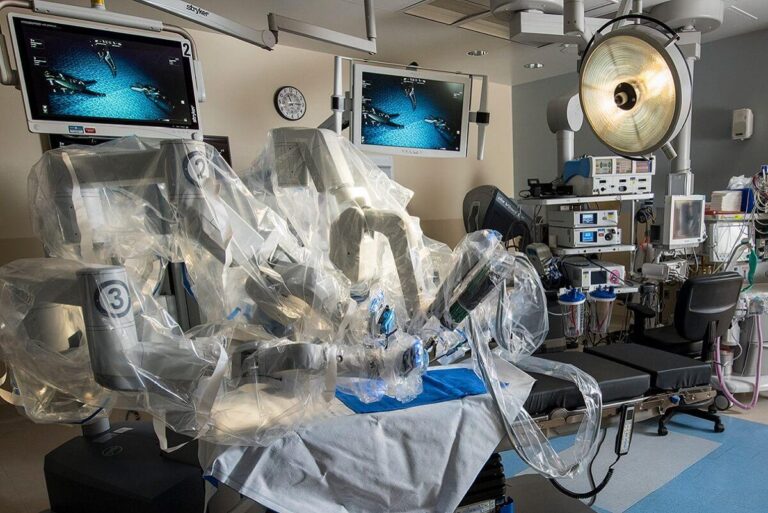In recent years, the field of surgery has witnessed a remarkable transformation fueled by advancements in robotic technology. The integration of robotics into modern surgical procedures is not only redefining precision and control in the operating room but also enhancing patient outcomes and recovery times.As these complex machines become increasingly prevalent, understanding their impact on surgical practices is essential for medical professionals, patients, and healthcare institutions alike. this article explores how robotics is shaping the future of surgery,highlighting key innovations,benefits,and challenges associated with this technological revolution.
Table of Contents
- Advancements in Robotic Technology Transforming Surgical precision
- Enhancing Patient Outcomes Through Minimally Invasive Robotics
- Training and Integration Challenges for Surgical Robotics in Clinical Practice
- Strategic Recommendations for Adopting Robotics in Healthcare institutions
- To Conclude
Advancements in Robotic Technology Transforming Surgical Precision
Robotic systems have revolutionized the precision of surgical procedures by integrating advanced imaging technologies with highly articulated instruments. These innovations allow surgeons to perform intricate maneuvers with unprecedented accuracy, minimizing human error and enhancing patient outcomes. features such as 3D visualization, tremor filtration, and enhanced dexterity have expanded the realm of minimally invasive surgeries, resulting in shorter recovery times, reduced scarring, and lower complication rates.
Key developments driving this transformation include:
- Real-time robotic guidance: providing dynamic adjustments during procedures to adapt to unexpected anatomical variations.
- artificial intelligence integration: assisting surgeons with predictive analytics and decision support based on vast surgical data.
- haptic feedback systems: delivering tactile sensations to enhance the surgeon’s control and situational awareness.
Collectively, these advancements are not only elevating surgical precision but also reshaping the future of patient care across multiple specialties.
Enhancing Patient Outcomes Through Minimally Invasive Robotics
The integration of robotic technology in surgical procedures has revolutionized the way healthcare professionals approach complex operations.Beyond the traditional scalpel, robotic systems offer enhanced precision and control, allowing surgeons to perform intricate tasks with minimal tissue disruption. This shift not only reduces the physical trauma experienced by patients but also significantly shortens recovery times. Patients benefit from smaller incisions, which minimizes the risk of infection and scarring, while the advanced imaging and dexterity of robotic tools provide unmatched accuracy during critical phases of surgery.
The ripple effects of such technological advancements extend across various aspects of patient care. key advantages include:
- Reduced postoperative pain, enabling faster mobilization and improved comfort.
- Lower complication rates, thanks to enhanced surgical precision.
- Decreased hospitalization duration, leading to cost savings and better resource allocation.
- Improved long-term outcomes, such as decrease in recurrence rates for certain conditions.
As the technology continues to evolve, the collaboration between human expertise and robotic innovation promises to redefine the standards of surgical excellence, ultimately elevating patient care to new heights.
Training and Integration Challenges for Surgical Robotics in Clinical Practice
The adoption of surgical robotics in healthcare settings demands a complete overhaul of traditional training models. Surgeons must acquire proficiency not only in robotic system operation but also in mastering the nuances of haptic feedback, 3D visualization, and instrument manipulation through remote interfaces. this steep learning curve often necessitates extensive simulation hours, interdisciplinary collaboration, and continuous skill assessment, which can strain time and resources. Additionally, institutions face the challenge of developing standardized curricula that accommodate varying levels of prior experience among surgical staff, ensuring that competency metrics are consistent yet adaptable.
Integrating robotic systems into established clinical workflows also introduces a multifaceted array of logistical and operational hurdles. These include:
- Compatibility issues with existing operating room infrastructure and technologies, which may require costly upgrades.
- Scheduling complexities as robotics procedures often demand longer setup and turnover times compared to conventional surgeries.
- Interdisciplinary dialog gaps that can impede coordination between surgeons, nurses, anesthesiologists, and technical staff.
Addressing these challenges demands strategic change management, robust technical support, and institutional commitment to fostering a culture of continuous learning and adaptability.
Strategic Recommendations for Adopting Robotics in Healthcare Institutions
Successfully integrating robotics within healthcare institutions demands a well-structured approach rooted in a thorough understanding of both technological capabilities and clinical workflows. Leaders must prioritize cross-disciplinary collaboration by engaging surgeons, engineers, and IT specialists early in the adoption process. This ensures that robotic systems are tailored to the specific needs of surgical teams,optimizing both usability and patient outcomes. Additionally, investing in comprehensive training programs is crucial; staff should be proficient not only in operating the machinery but also in troubleshooting and maintaining equipment to minimize downtime and enhance safety.
Financial and operational planning also plays an essential role in maximizing the benefits of surgical robotics. institutions should conduct detailed cost-benefit analyses, including factors such as initial acquisition expenses, ongoing maintenance, and potential reductions in postoperative complications. Emphasizing a phased rollout strategy can mitigate risks and allow for iterative improvements based on user feedback. Moreover, adapting hospital infrastructure to accommodate robotic units — including dedicated space, sterilization protocols, and data management systems — will foster a seamless integration that drives sustained innovation.
- Engage multidisciplinary teams for system customization and workflow alignment
- Implement robust training and certification pathways for clinical and technical staff
- Adopt a phased implementation plan to evaluate performance and scalability
- Align budget planning with operational and maintenance needs
- Upgrade facility infrastructure and data systems to support robotic technologies
To Conclude
the integration of robotics into modern surgical procedures marks a meaningful milestone in the evolution of healthcare. By enhancing precision, reducing recovery times, and minimizing complications, robotic surgery is reshaping the landscape of patient care.As technology continues to advance,the collaboration between skilled surgeons and sophisticated robotic systems promises to unlock new possibilities,ultimately improving outcomes and expanding the boundaries of what is surgically achievable. Staying informed about these developments is essential for both medical professionals and patients eager to embrace the future of surgery.

